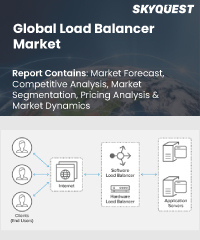USD 4.82 billion

Global Load Balancer Market Size, Share, Growth Analysis, By Component(Hardware, Software), By Service(Training and Consulting, Integration and Deployment), By Type(Local Load Balancer, and Global Load Balancer), By Deployment(Cloud, and On-premise), By Enterprise size(Large Enterprises, and Small & Medium Enterprises (SMEs)), By End-Use(BFSI, Retail) - Industry Forecast 2024-2031
Report ID:
SQMIG45A2182 |
Region:
Global |
Published Date: February, 2024
Pages:
157
|
Tables:
172 |
Figures:
79
Global Load Balancer Market Insights
Load Balancer Market size was valued at USD 4.82 billion in 2021 and is poised to grow from USD 5.33 billion in 2022 to USD 16.14 billion by 2030, growing at a CAGR of 14.8% in the forecast period (2023-2030).
The market's electrical power growth can be assigned to a number of factors, including an increase in the use of cloud load balancing services, increased business awareness of the advantages of networking and cloud technologies, the adoption of connected devices, and remote working practices.
This collaboration aims to develop integrations between Red Hat Openshift Container System, Red Hat Ansible Automation Platform, and F5 technologies. The collaboration assures that organizations shift to cloud-native operations and opens the door for non-traditional consumers of F5 services.
The increase in internet traffic can have an impact on server performance, but load-balancing gives the group the option to deploy more servers to accommodate the growing volume of incoming requests. Instead of migrating to a brand-new environment as necessary, customers can add more load balancers. Additionally, the server's configuration can be modified according to the needs of the company and the site's traffic.
For instance, during a sales season, a retail website can see considerable traffic; in this scenario, installing extra load-balanced internet servers will help lower latency. Other back-end servers will assume responsibility for ensuring traffic that comes in and maintaining the services if one server stops responding.
The interconnection of Internet of Things (IoT) devices requires robust request processing capabilities, which has led to widespread use of load balancers. The multi-access computing edge revolution and various firms' global sensor deployment programmes are driving growth in the load balancer market. For instance, Amazon Web Services introduced the Gateway Load Balancer, which scales and controls virtual appliances from third parties such as firewalls, intrusion detection and prevention systems, and advanced packet inspection devices in the cloud.
The ongoing deployment of IoT networks & the resulting rise in IoT traffic are both encouraging signs for the market's expansion. The aggressive implementation of the Bring Your Own Device (BYOD) policy by numerous organizations is also anticipated to increase the uptake of load-balancing systems. Load-balancing solutions are being implemented into business contexts through technologies like Azure Application Gateway, which offers improved and organized accessibility for communication at the security and network layers. Due to the rise in cyberattacks, including malware, phishing, along Denial of Service (DoS) attacks that target corporate networks, load balancing services are also essential.
The expansion of the market is anticipated to be constrained during the projected period by cyberattacks and the high cost of load-balancing network solutions. Many nations, including China, are taking action to stop data breaches. In January 2022, the China Cyberspace Administration (CAC) published a draft regulation on networking data security management.
Market snapshot - 2024-2031
Global Market Size
Largest Segment
Local Load Balancer
Fastest Growth
Local Load Balancer
Growth Rate
14.8% CAGR
To get more reports on the above market click here to Buy The Report
Global Load Balancer Market Segmental Analysis
The global load balancer market is segmented on the basis of component, service, type, deployment, enterprise size, end-use and region. Based on components the market is segmented into Hardware, Software, and Services. Based on Service, the market is segmented into Training and Consulting, Integration and Deployment, Support and Maintenance. Based on Type the market is segmented into Local Load Balancer, Global Load Balancer. Based on Deployment, the market is segmented into Cloud, On-premise. Based on Enterprise size the market is segmented into Large Enterprises, Small & Medium Enterprises (SMEs). Based on End-Use the market is segmented into BFSI, Retail, Government, Manufacturing, IT & Telecom, Healthcare, Others. Based on region the global Load Balancer Market is segmented into North America, Europe, Asia-Pacific, South America, and MEA.
Load Balancer Market Analysis by Component
The hardware sector held the biggest market share with 56.6%. The segment's expansion can be linked to its capacity for performing the most resource-intensive tasks, including UDP (User Datagram Protocol) traffic processing, distributed denial for service protection, and SSL offloading. Since large enterprises desire to share a multitenant device across business units, hardware load balancers offer important benefits. Enterprises may achieve compliance on a broad scale with the help of hardware-based App Delivery Controllers (ADCs), which is crucial for the local and state government sectors. These elements are anticipated to boost market expansion throughout the anticipated time frame.
The software segment is predicted to expand at a CAGR of 15.8% throughout the projection period. Demand for load balancers is being driven by the growing requirement for sophisticated network management systems to manage the complexity of network traffic and the rapidly growing cybercrime. The urgent requirement to ensure communication accessibility at both the systems and device levels is another factor fueling the market's growth.
By quickly and effectively adapting to changes in internet traffic by adding or deleting virtual servers as necessary, these advantages help the industry flourish. Additionally, the use of load-balancing software between the server and client may block suspicious signals before they reach the server side, adding an additional layer of security, which is fueling the growth in the use of software in the anticipated time frame.
Load Balancer Market Analysis by Type
The market share held by the worldwide load balancing segment is 69.0% for the local load balancer segment. The benefit of providing support for regional or local-level disruptions, mission-critical continuation of operations, to global catastrophe recovery can be credited with the segment's rise. Additionally, it aids network architects in meeting governmental regulations for several heavily regulated businesses, like defense, telecommunications, and healthcare, while providing services to a worldwide user base.
As an illustration, a global load balancer can be programmed to only send requests to Canadian data centers if they come from Canadian users and not from users from any other nation. Global load balancers are anticipated to see critical acceptance due to the growth of connected data center structures that require efficient load balancing to provide optimal performance.
Due to their quick reaction times & speed for a better user experience, local load balancers are anticipated to develop at a CAGR of 13.7% during the projection period. No matter the location or as users use the network, load balancing prevents server overload and keeps it responsive. Without causing downtime or altering the current systems, it offers the dynamic addition or deletion of the servers in reaction to traffic peaks.
To get detailed analysis on other segments, Request For Free Sample Report
Global Load Balancer Market Regional Insights
The North American market for load balancers led the world market with a 33.4% share. The development of cloud computing services began in North America, where every sphere of the local economy has embraced cloud-based solutions. Load balancers are being incorporated by many companies into their infrastructure systems in order to maintain performance and flexibility, which is expected to spur market growth.
The Asia Pacific market is anticipated to expand to become the fastest-growing regional market with a CAGR of 16.8%. Businesses shunning traditional management methods, expanding desire for automated solutions, and optimizing of all firm management components are all contributing to the market's growth. In order to increase its skills in the fields of meteorology, quantum technologies & materials, quantitative communications, and quantum information, India is going to invest USD 1 billion over the course of five years from now in a number of programmes. These significant factors are what are driving the need for a load balancer in the area.
- Largest
- Fastest
To know more about the market opportunities by region and country, click here to
Buy The Complete Report
Global Load Balancer Market Dynamics
Load Balancer Market Drivers
Increasing Demand for High-Performance Applications
- With the growth of digitalization and the increasing reliance on online services, there is a growing demand for high-performance applications that can handle heavy traffic and deliver a seamless user experience. Load balancers play a crucial role in distributing incoming network traffic across multiple servers or resources, ensuring optimal performance and scalability.
Rising Adoption of Cloud Computing
- Cloud computing has gained significant traction due to its scalability, cost-efficiency, and flexibility. Load balancers are essential components of cloud infrastructure, enabling efficient distribution of traffic among cloud servers or instances. As organizations continue to migrate their applications and services to the cloud, the demand for load balancers is expected to rise.
Load Balancer Market Restraints
Lack of Awareness and Understanding
- Some organizations may not fully understand the benefits and functionalities of load balancers. There may be a lack of awareness about how load balancers can improve application performance, scalability, and security. Limited awareness and understanding of load balancers can hinder their adoption in certain markets or industries.
Request Free Customization of this report to help us to meet your business objectives.
Global Load Balancer Market Competitive Landscape
Players in the market are deemed to spend money on R&D projects to advance their internal business processes and assist growth. Companies are often observed participating in mergers, acquisitions, and joint ventures to improve their products and acquire a competitive edge in the market. In order to attract new clients and increase market share, they are actively working on the development of new items and the improvement of existing ones.
Load Balancer Market Top Player’s Company Profiles
- F5 Networks, Inc.
- Citrix Systems, Inc.
- A10 Networks, Inc.
- Radware Ltd.
- Kemp Technologies, Inc.
- Fortinet, Inc.
- NGINX (acquired by F5 Networks)
- Cisco Systems, Inc.
- Barracuda Networks, Inc.
- HAProxy Technologies SARL
- Avi Networks (acquired by VMware)
- Brocade Communications Systems, Inc.
- Array Networks, Inc.
- JetNexus Solutions Ltd.
- Loadbalancer.org Ltd.
- Pulse Secure, LLC (formerly known as Brocade vADC)
- Snapt Inc.
- Sangfor Technologies, Inc.
- Incapsula Inc. (acquired by Imperva)
- Hystrix Medical (acquired by Radware)
Load Balancer Market Recent Developments
- In June 2021, F5 Networks, a leading player in the load balancer market, announced the acquisition of Volterra, a provider of cloud-native networking solutions. This acquisition aimed to enhance F5's capabilities in delivering edge services and edge-as-a-service solutions.
- In April 2021, Citrix Systems, another prominent player in the load balancer market, introduced new features and enhancements to its ADC (Application Delivery Controller) product line. These updates focused on improving performance, security, and operational efficiency for application delivery in hybrid and multi-cloud environments.
Global Load Balancer Key Market Trends
- Growing Adoption of Cloud-Based Load Balancers: Organizations are increasingly shifting their infrastructure to the cloud, leading to a higher demand for cloud-based load balancers. Cloud load balancers offer scalability, flexibility, and efficient resource utilization, making them a popular choice for managing traffic and optimizing application performance in cloud environments.
- Rising Demand for Application Delivery Controllers (ADCs): ADCs, a type of load balancer, are gaining traction due to their ability to improve application performance, enhance security, and provide advanced traffic management capabilities. With the increasing complexity of applications and the need for seamless user experiences, the demand for ADCs is expected to grow.
- Focus on Security and SSL/TLS Encryption: As cyber threats continue to evolve, organizations are prioritizing the security of their applications and data. Load balancers are playing a crucial role in securing applications by providing SSL/TLS encryption and offloading, ensuring the secure transmission of sensitive information between clients and servers.
- Emphasis on Multi-Cloud and Hybrid Cloud Deployments: With the popularity of multi-cloud and hybrid cloud environments, load balancers that can distribute traffic across multiple cloud providers or on-premises infrastructure are in high demand. These load balancers enable organizations to achieve better workload distribution, redundancy, and scalability across diverse environments.
- Integration with containerization and microservices: Load balancers are adapting to the growing trend of containerization and microservices architectures. They provide dynamic traffic management and load distribution for containerized applications and facilitate seamless communication between microservices, ensuring optimal performance and scalability.
Global Load Balancer Market SkyQuest Analysis
SkyQuest’s ABIRAW (Advanced Business Intelligence, Research & Analysis Wing) is our Business Information Services team that Collects, Collates, Co-relates and Analyzes the Data collected by means of Primary Exploratory Research backed by the robust Secondary Desk research.
According to our global load balancer market analysis, the growth in the market's electrical power growth can be attributed to a number of factors, including an increase in the use of cloud load balancing services, increased business awareness of the advantages of networking and cloud technologies, the adoption of connected devices, and remote working practices.
However, Asia Pacific is projected to emerge as the fastest growing region during the forecast period due to Businesses shunning traditional management methods, expanding desire for automated solutions, and optimizing all firm management components are all contributing to the market's growth. In order to increase its skills in the fields of meteorology, quantum technologies & materials, quantitative communications, and quantum information, India is going to invest USD 1 billion over the course of five years from now in a number of programmes.
| Report Metric | Details |
|---|---|
| Market size value in 2023 | USD 4.82 billion |
| Market size value in 2031 | USD 16.14 billion |
| Growth Rate | 14.8% |
| Forecast period | 2024-2031 |
| Forecast Unit (Value) | USD Billion |
| Segments covered |
|
| Regions covered | North America (US, Canada), Europe (Germany, France, United Kingdom, Italy, Spain, Rest of Europe), Asia Pacific (China, India, Japan, Rest of Asia-Pacific), Latin America (Brazil, Rest of Latin America), Middle East & Africa (South Africa, GCC Countries, Rest of MEA) |
| Companies covered |
|
| Customization scope | Free report customization with purchase. Customization includes:-
|
To get a free trial access to our platform which is a one stop solution for all your data requirements for quicker decision making. This platform allows you to compare markets, competitors who are prominent in the market, and mega trends that are influencing the dynamics in the market. Also, get access to detailed SkyQuest exclusive matrix.
Buy The Complete Report to read the analyzed strategies adopted by the top vendors either to retain or gain market share
Table Of Content
Executive Summary
Market overview
- Exhibit: Executive Summary – Chart on Market Overview
- Exhibit: Executive Summary – Data Table on Market Overview
- Exhibit: Executive Summary – Chart on Global Load Balancer Market Characteristics
- Exhibit: Executive Summary – Chart on Market by Geography
- Exhibit: Executive Summary – Chart on Market Segmentation
- Exhibit: Executive Summary – Chart on Incremental Growth
- Exhibit: Executive Summary – Data Table on Incremental Growth
- Exhibit: Executive Summary – Chart on Vendor Market Positioning
Parent Market Analysis
Market overview
Market size
- Market Dynamics
- Exhibit: Impact analysis of DROC, 2021
- Drivers
- Opportunities
- Restraints
- Challenges
- Exhibit: Impact analysis of DROC, 2021
- SWOT Analysis
KEY MARKET INSIGHTS
- Technology Analysis
- (Exhibit: Data Table: Name of technology and details)
- Pricing Analysis
- (Exhibit: Data Table: Name of technology and pricing details)
- Supply Chain Analysis
- (Exhibit: Detailed Supply Chain Presentation)
- Value Chain Analysis
- (Exhibit: Detailed Value Chain Presentation)
- Ecosystem Of the Market
- Exhibit: Parent Market Ecosystem Market Analysis
- Exhibit: Market Characteristics of Parent Market
- IP Analysis
- (Exhibit: Data Table: Name of product/technology, patents filed, inventor/company name, acquiring firm)
- Trade Analysis
- (Exhibit: Data Table: Import and Export data details)
- Startup Analysis
- (Exhibit: Data Table: Emerging startups details)
- Raw Material Analysis
- (Exhibit: Data Table: Mapping of key raw materials)
- Innovation Matrix
- (Exhibit: Positioning Matrix: Mapping of new and existing technologies)
- Pipeline product Analysis
- (Exhibit: Data Table: Name of companies and pipeline products, regional mapping)
- Macroeconomic Indicators
COVID IMPACT
- Introduction
- Impact On Economy—scenario Assessment
- Exhibit: Data on GDP - Year-over-year growth 2016-2022 (%)
- Revised Market Size
- Exhibit: Data Table on Global Load Balancer Market size and forecast 2021-2027 ($ million)
- Impact Of COVID On Key Segments
- Exhibit: Data Table on Segment Market size and forecast 2021-2027 ($ million)
- COVID Strategies By Company
- Exhibit: Analysis on key strategies adopted by companies
MARKET DYNAMICS & OUTLOOK
- Market Dynamics
- Exhibit: Impact analysis of DROC, 2021
- Drivers
- Opportunities
- Restraints
- Challenges
- Exhibit: Impact analysis of DROC, 2021
- Regulatory Landscape
- Exhibit: Data Table on regulation from different region
- SWOT Analysis
- Porters Analysis
- Competitive rivalry
- Exhibit: Competitive rivalry Impact of key factors, 2021
- Threat of substitute products
- Exhibit: Threat of Substitute Products Impact of key factors, 2021
- Bargaining power of buyers
- Exhibit: buyers bargaining power Impact of key factors, 2021
- Threat of new entrants
- Exhibit: Threat of new entrants Impact of key factors, 2021
- Bargaining power of suppliers
- Exhibit: Threat of suppliers bargaining power Impact of key factors, 2021
- Competitive rivalry
- Skyquest special insights on future disruptions
- Political Impact
- Economic impact
- Social Impact
- Technical Impact
- Environmental Impact
- Legal Impact
Market Size by Region
- Chart on Market share by geography 2021-2027 (%)
- Data Table on Market share by geography 2021-2027(%)
- North America
- Chart on Market share by country 2021-2027 (%)
- Data Table on Market share by country 2021-2027(%)
- USA
- Exhibit: Chart on Market share 2021-2027 (%)
- Exhibit: Market size and forecast 2021-2027 ($ million)
- Canada
- Exhibit: Chart on Market share 2021-2027 (%)
- Exhibit: Market size and forecast 2021-2027 ($ million)
- Europe
- Chart on Market share by country 2021-2027 (%)
- Data Table on Market share by country 2021-2027(%)
- Germany
- Exhibit: Chart on Market share 2021-2027 (%)
- Exhibit: Market size and forecast 2021-2027 ($ million)
- Spain
- Exhibit: Chart on Market share 2021-2027 (%)
- Exhibit: Market size and forecast 2021-2027 ($ million)
- France
- Exhibit: Chart on Market share 2021-2027 (%)
- Exhibit: Market size and forecast 2021-2027 ($ million)
- UK
- Exhibit: Chart on Market share 2021-2027 (%)
- Exhibit: Market size and forecast 2021-2027 ($ million)
- Rest of Europe
- Exhibit: Chart on Market share 2021-2027 (%)
- Exhibit: Market size and forecast 2021-2027 ($ million)
- Asia Pacific
- Chart on Market share by country 2021-2027 (%)
- Data Table on Market share by country 2021-2027(%)
- China
- Exhibit: Chart on Market share 2021-2027 (%)
- Exhibit: Market size and forecast 2021-2027 ($ million)
- India
- Exhibit: Chart on Market share 2021-2027 (%)
- Exhibit: Market size and forecast 2021-2027 ($ million)
- Japan
- Exhibit: Chart on Market share 2021-2027 (%)
- Exhibit: Market size and forecast 2021-2027 ($ million)
- South Korea
- Exhibit: Chart on Market share 2021-2027 (%)
- Exhibit: Market size and forecast 2021-2027 ($ million)
- Rest of Asia Pacific
- Exhibit: Chart on Market share 2021-2027 (%)
- Exhibit: Market size and forecast 2021-2027 ($ million)
- Latin America
- Chart on Market share by country 2021-2027 (%)
- Data Table on Market share by country 2021-2027(%)
- Brazil
- Exhibit: Chart on Market share 2021-2027 (%)
- Exhibit: Market size and forecast 2021-2027 ($ million)
- Rest of South America
- Exhibit: Chart on Market share 2021-2027 (%)
- Exhibit: Market size and forecast 2021-2027 ($ million)
- Middle East & Africa (MEA)
- Chart on Market share by country 2021-2027 (%)
- Data Table on Market share by country 2021-2027(%)
- GCC Countries
- Exhibit: Chart on Market share 2021-2027 (%)
- Exhibit: Market size and forecast 2021-2027 ($ million)
- South Africa
- Exhibit: Chart on Market share 2021-2027 (%)
- Exhibit: Market size and forecast 2021-2027 ($ million)
- Rest of MEA
- Exhibit: Chart on Market share 2021-2027 (%)
- Exhibit: Market size and forecast 2021-2027 ($ million)
KEY COMPANY PROFILES
- Competitive Landscape
- Total number of companies covered
- Exhibit: companies covered in the report, 2021
- Top companies market positioning
- Exhibit: company positioning matrix, 2021
- Top companies market Share
- Exhibit: Pie chart analysis on company market share, 2021(%)
- Total number of companies covered
Methodology
For the Global Load Balancer Market, our research methodology involved a mixture of primary and secondary data sources. Key steps involved in the research process are listed below:
1. Information Procurement: This stage involved the procurement of Market data or related information via primary and secondary sources. The various secondary sources used included various company websites, annual reports, trade databases, and paid databases such as Hoover's, Bloomberg Business, Factiva, and Avention. Our team did 45 primary interactions Globally which included several stakeholders such as manufacturers, customers, key opinion leaders, etc. Overall, information procurement was one of the most extensive stages in our research process.
2. Information Analysis: This step involved triangulation of data through bottom-up and top-down approaches to estimate and validate the total size and future estimate of the Global Load Balancer Market.
3. Report Formulation: The final step entailed the placement of data points in appropriate Market spaces in an attempt to deduce viable conclusions.
4. Validation & Publishing: Validation is the most important step in the process. Validation & re-validation via an intricately designed process helped us finalize data points to be used for final calculations. The final Market estimates and forecasts were then aligned and sent to our panel of industry experts for validation of data. Once the validation was done the report was sent to our Quality Assurance team to ensure adherence to style guides, consistency & design.
Analyst Support
Customization Options
With the given market data, our dedicated team of analysts can offer you the following customization options are available for the Global Load Balancer Market:
Product Analysis: Product matrix, which offers a detailed comparison of the product portfolio of companies.
Regional Analysis: Further analysis of the Global Load Balancer Market for additional countries.
Competitive Analysis: Detailed analysis and profiling of additional Market players & comparative analysis of competitive products.
Go to Market Strategy: Find the high-growth channels to invest your marketing efforts and increase your customer base.
Innovation Mapping: Identify racial solutions and innovation, connected to deep ecosystems of innovators, start-ups, academics, and strategic partners.
Category Intelligence: Customized intelligence that is relevant to their supply Markets will enable them to make smarter sourcing decisions and improve their category management.
Public Company Transcript Analysis: To improve the investment performance by generating new alpha and making better-informed decisions.
Social Media Listening: To analyze the conversations and trends happening not just around your brand, but around your industry as a whole, and use those insights to make better Marketing decisions.
Global Load Balancer Market Report Snapshots
Want to customize this report?
Our industry expert will work with you to provide you with customized data in a short amount of time.
REQUEST FREE CUSTOMIZATION



 USA (+1) 617-230-0741
USA (+1) 617-230-0741
